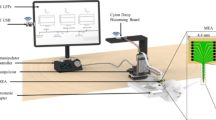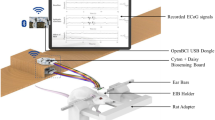Abstract
Epilepsy is a chronic nervous disease with increasing incidence worldwide, while the accurate localization of epileptic focus and the corresponding treatment are still challenging due to the lack of effective tools to monitor and modulate the related brain neurological activities. In this work, stretchable micro electrocorticogram (mECoG) electrodes are developed and used to investigate penicillin-induced epilepsy in rats. The electrodes possess excellent stretchability, conformality, anti-interference ability and sufficient resolution to successfully monitor electroencephalogram (EEG) signals, which is superior to traditional rigid polyimide-based electrodes. Characteristic epileptic spike waves are detected and analyzed to study the epileptic focus and electrical stimulus effects during epileptic seizures. It is found that the spike waves occur first in the visual cortex which is likely to be the epileptic focus. Epileptic spike wave frequency quickly increases to 1.07 Hz where it reaches a plateau and remains stable. There is no dominant brain hemisphere that would show early warning of epileptic seizures. Electrical stimuli for various times are applied after administering penicillin. It is found that 15 min of electrical stimulus has the best restraining effect on epileptic seizures. The mECoG electrodes developed in this study show potentials for applications in stretchable biomedical devices.
摘要
癫痫是一种慢性神经系统疾病, 其发病率在全球范围内不断上升, 但由于缺乏有效的工具来监测和调节相关的脑神经活动, 癫痫病灶的准确定位和相应的治疗仍然具有挑战性. 在这项工作中, 我们开发了可拉伸微脑皮层(mECoG)电极, 并用于研究青霉素诱导的大鼠癫痫发作. 该电极具有良好的延展性、 共形性、 抗干扰能力和高分辨率, 能够成功地监测脑电信号, 并优于传统的刚性聚酰亚胺电极. 通过检测和分析特征性癫痫棘波, 我们研究了癫痫发作期间的癫痫灶和电刺激效应. 研究发现, 棘波首先出现在视皮层, 很可能是癫痫的病灶. 癫痫发作后棘波频率迅速增加至1.07 Hz, 达到平台并保持稳定. 没有一个大脑半球可以显示癫痫发作的早期预警. 青霉素诱导后, 我们施加了不同时长的电刺激. 研究发现, 15分钟的电刺激对癫痫发作的抑制效果最好. 本研究开发的mECoG电极在可拉伸生物医学器件中具有应用前景
Similar content being viewed by others
References
Chang EF, Barbaro NM. Epilepsy surgery: The Emerging field of neuromodulation. Neurosurg Clin N Am, 2011, 22: ix–x
Prabhu S, Chabardès S, Sherdil A, et al. Effect of subthalamic nucleus stimulation on penicillin induced focal motor seizures in primate. Brain Stimul, 2015, 8: 177–184
Wolf P. Reflex epileptic mechanisms in humans: Lessons about natural ictogenesis. Epilepsy Behav, 2017, 71: 118–123
Zhao T, Feng X, Liu J, et al. Evaluate the efficacy and safety of anti-epileptic medications for partial seizures of epilepsy: A network metaanalysis. J Cell Biochem, 2017, 118: 2850–2864
Singh T, Kaur T, Goel RK. Ferulic acid supplementation for management of depression in epilepsy. Neurochem Res, 2017, 42: 2940–2948
Kotwas I, McGonigal A, Bastien-Toniazzo M, et al. Stress regulation in drug-resistant epilepsy. Epilepsy Behav, 2017, 71: 39–50
Zhang G, Meng D, Liu Y, et al. Epileptic zone resection for magnetic resonance imaging-negative refractory epilepsy originating from the primary motor cortex. World Neurosurg, 2017, 102: 434–441
Cheng H, Kuang Y, Liu Y, et al. Low-frequency stimulation of the external globus palladium produces anti-epileptogenic and anti-ictogenic actions in rats. Acta Pharmacol Sin, 2015, 36: 957–965
Wyckhuys T, Raedt R, Vonck K, et al. Comparison of hippocampal deep brain stimulation with high (130 Hz) and low frequency (5 Hz) on afterdischarges in kindled rats. Epilepsy Res, 2010, 88: 239–246
Wyckhuys T, Boon P, Raedt R, et al. Suppression of hippocampal epileptic seizures in the kainate rat by poisson distributed stimulation. Epilepsia, 2010, 51: 2297–2304
Chen YC, Zhu GY, Wang X, et al. Deep brain stimulation of the anterior nucleus of the thalamus reverses the gene expression of cytokines and their receptors as well as neuronal degeneration in epileptic rats. Brain Res, 2017, 1657: 304–311
Jiruska P, Powell AD, Deans JK, et al. Effects of direct brain stimulation depend on seizure dynamics. Epilepsia, 2010, 51: 93–97
Fan D, Liu S, Wang Q. Stimulus-induced epileptic spike-wave discharges in thalamocortical model with disinhibition. Sci Rep, 2016, 6: 37703
Chen R, Spencer DC, Weston J, et al. Transcranial magnetic stimulation for the treatment of epilepsy. Cochrane Database Systatic Rev, 2021, 4: CD011025
Liu Z, Yu M, Lv J, et al. Dispersed, porous nanoislands landing on stretchable nanocrack gold films: Maintenance of stretchability and controllable impedance. ACS Appl Mater Interfaces, 2014, 6: 13487–13495
Hesdorffer DC, Beck V, Begley CE, et al. Research implications of the institute of medicine report, epilepsy across the spectrum: Promoting health and understanding. Epilepsia, 2013, 54: 207–216
Thomas GP, Jobst BC. Critical review of the responsive neurostimulator system for epilepsy. Med Dev Evid Res, 2015, 8: 405–411
Kinoshita M, Ikeda A, Matsumoto R, et al. Electric stimulation on human cortex suppresses fast cortical activity and epileptic spikes. Epilepsia, 2004, 45: 787–791
Avoli M. Feline generalized penicillin epilepsy. Ital J Neuro Sci, 1995, 16: 79–82
Roses AD, Pericak-Vance MA, Saunders AM, et al. Complex genetic disease: Can genetic strategies in alzheimer’s disease and new genetic mechanisms be applied to epilepsy? Epilepsia, 1994, 35: S20–S28
Schreiber W, Krieg JC. Das Hoigné-syndrom. Der Nervenarzt, 2001, 72: 546–548
New PS, Wells CE. Cerebral toxicity associated with massive intravenous penicillin therapy. Neurology, 1965, 15: 1053
Penfield W, Boldrey E. Somatic motor and sensory representation in the cerebral cortex of man as studied by electrical stimulation. Brain, 1937, 60: 389–443
Elisevich K, Jenrow K, Schuh L, et al. Long-term electrical stimulation-induced inhibition of partial epilepsy. J Neurosurg, 2006, 105: 894–897
Jiruska P, Alvarado-Rojas C, Schevon CA, et al. Update on the mechanisms and roles of high-frequency oscillations in seizures and epileptic disorders. Epilepsia, 2017, 58: 1330–1339
Acknowledgements
This work was financially supported by the National Key Scientific Research Instrument Development Project (81927804), the Major Scientific and Technological Innovation Projects of Shandong Province (2019JZZY011112), the Clinical Research Project of Shandong University (2020SDUCRCB004), and the National Nature Science Foundation of China (81960419 and 81760416).
Author information
Authors and Affiliations
Contributions
Author contributions Zhang Q, Zhao Y and Wang L performed the experiments and analyzed the data; Yu M helped with the preparation of electrodes; Wei M and Huang J conducted the animal experiment under the guidance of Du S; Li G and Liu Z provided research suggestions and guidance. All authors contributed to the writing of the manuscript.
Corresponding authors
Ethics declarations
Conflict of interest The authors declare that they have no conflict of interest.
Additional information
Supplementary information Movies and script of EEG data processing are available in the online version of the paper.
Qi Zhang obtained his bachelor, master and PhD degrees from Xiamen University in China. Currently he is working at the College of Physics and Optoelectronic Engineering, Shenzhen University in China as a postdoc. His research interests include stretchable electrodes, flexible sensors, deep learning and image recognition technology.
Yang Zhao got his bachelor degree from Beihang University in China and PhD degree from the University of Manchester in UK. Currently he is working at the Neural Engineering Center, Shenzhen Institute of Advanced Technology, Chinese Academy of Sciences as an assistant professor. His research interests include flexible and stretchable electronic materials and corresponding sensors and devices for wearable and healthcare applications.
Lin Wang received her PhD degree in mechanical engineering at the University of Bristol, UK. Afterwards, she worked as a postdoctoral researcher at the Chinese University of Hong Kong and the University of Liverpool, UK, respectively. She is currently a professor at Shenzhen Institute of Advanced Technology, Chinese Academy of Sciences. Her research interests lie on the neuro-musculoskeletal biomechanics and ergonomics, as well as intelligent control of the rehabilitation systems for the motion dysfunctional lower limb.
Shiwei Du graduated from the Chinese Academy of Medical Sciences & Peking Union Medical College with an MD degree. Currently he is working at the Department of Neurosurgery, South China Hospital of Shenzhen University as director and chief physician. His research topics include wearable electronics, artificial bionic vascular, brain computer interface and exosome.
Zhiyuan Liu got his bachelor’s degree and master’s degree from Harbin Institute of Technology, and his PhD degree from Nanyang Technological University, Singapore. He is currently a professor at Shenzhen Institutes of Advanced Technology, Chinese Academy of Sciences. He has continuously focused on the research of bio-interface soft/stretchable electronic devices for more than ten years and is experienced in interdisciplinary bio-medical studies.
Supplementary information
40843_2021_2043_MOESM1_ESM.pdf
Localizing epileptic focus and assessing electrical stimulus effects on epilepsy in rats using stretchable micro electrocorticogram electrodes
Rights and permissions
About this article
Cite this article
Zhang, Q., Zhao, Y., Wang, L. et al. Localizing epileptic focus and assessing electrical stimulus effects on epilepsy in rats using stretchable micro electrocorticogram electrodes. Sci. China Mater. 65, 2244–2251 (2022). https://doi.org/10.1007/s40843-021-2043-5
Received:
Accepted:
Published:
Issue Date:
DOI: https://doi.org/10.1007/s40843-021-2043-5




